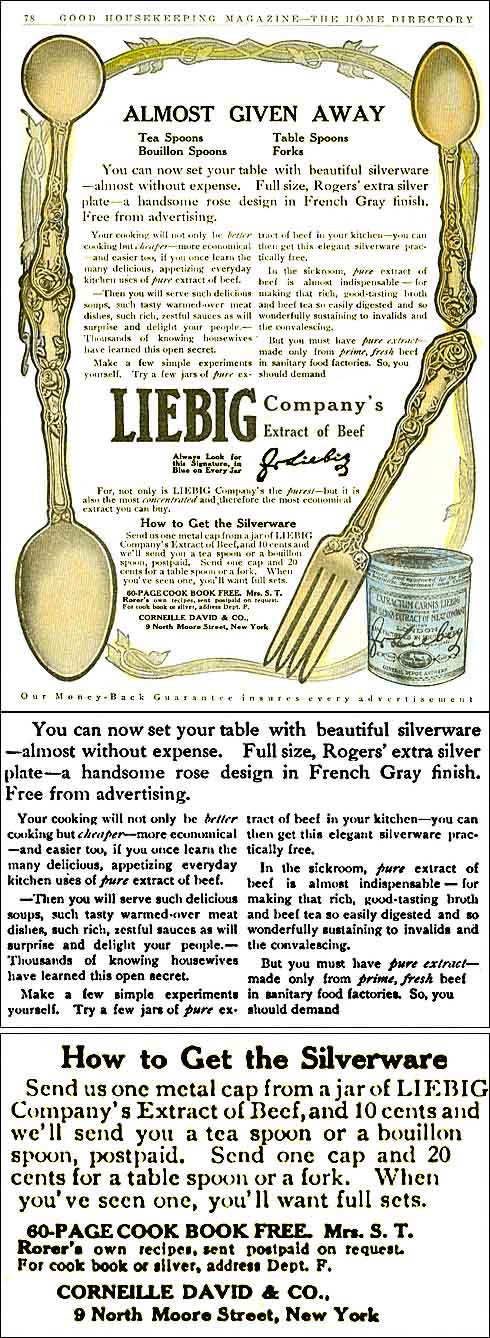quote:
[<gone from the internet> .answers.com/topic/liebig-extract-of-meat-company]
Liebig Extract of Meat CompanyThe Liebig Extract of Meat Company was the originator of Oxo beef stock cubes. It was named after [<gone from the internet> .answers.com/main/ntquery;jsessionid=qcqdkl504s2b?method=4&dsid=2222&dekey=Justus+von+Liebig&gwp=8&curtab=2222_1&sbid=lc01b]Baron Justus von Liebig, the German-born 19th-century organic chemist who founded it.
Baron von Liebig specialized in chemistry and the classification of food and wrote a paper on how boiling meat destroys its nutritional value. Fueled by a desire to help feed the undernourished, in 1840 he developed a concentrated beef extract to provide a cheap and nutritious meat substitute for those unable to afford the real thing.
George Christian Giebert, a young engineer, read of Liebig's work and wrote to him suggesting that they meet to discuss opening a manufacturing plant in Uruguay, South America. The Liebig Extract of Meat Company was established on 4 December 1865 in London, England and set about opening a factory to meet demand for the extract. The factory was opened in 1866 on the banks of the Uruguay River at Villa Independencia, later called Fray Bentos, where the extract was manufactured using the flesh of cattle that would otherwise have been killed for their hides alone.
The extract came in the form of a molasses-like black spread packaged in a glass bottle. It was promoted in Europe as being invaluable not only as a supplement for the malnourished but also in the kitchen. The product enjoyed a meteoric rise in popularity. By 1875, 500 tonnes of the extract were being produced at Fray Bentos plant each year. It became a staple in middle-class European households and for soldiers, including the Allied forces of World War II. It was even used by European adventurers such as Sir Henry Morton Stanley on this trip to Africa.
In 1873, Liebig's began producing tinned corned beef, sold under the label Fray Bentos. Later, freezer units were installed, enabling the company to also export frozen and chilled raw meat.
The extract became known as [<gone from the internet> .answers.com/main/ntquery;jsessionid=qcqdkl504s2b?method=4&dsid=2222&dekey=Oxo+%28food%29&gwp=8&curtab=2222_1&sbid=lc01b]
Oxo
in 1899.
In the 1920s, the company acquired the Oxo Tower Wharf on the south bank of the river Thames in London. There they erected a factory, demolishing most of the original building and preserving and building upon the riverside frontage.
The Liebig Extract of Meat Company was acquired by the Vestey Group in 1924 and the factory was renamed El Anglo.
The works and yards at Fray Bentos ranked among the largest industrial complexes in South America and helped usher in the industrial revolution there. The plant played a major role in the development of Uruguay's cattle sector, which is still one of the country's main sources of export products. It attracted many European immigrants and, in its heyday, had 5,000 employees. It is said that an animal was processed every five minutes. Every part of the animal was used.
In 1964, a typhoid outbreak in Aberdeen was traced to Fray Bentos corned beef. Investigations revealed that the cooling water used in the canning process at the plant was not being consistently chlorinated. Meanwhile, Britain's entry into the Common Market affected trade patterns. These factors combined had a serious negative impact on sales, and in 1971, the complex was given to the Uruguayan government. The plant's viability never recovered and the production ceased completely in 1979, a major blow to the area's residents. The complex is now an industrial museum.
Fray Bentos canned meats, now owned by Campbell's, are still sold in Europe. The brand also offers meat pies, which have been manufactured in England since 1958.
A popular cookbook, The Liebig Company's Practical Cookery Book by Hannah M. Young, was published in 1894 and re-released in 1999 (David Brown Book Co., ISBN 1870962168).
This entry is from Wikipedia, the leading user-contributed encyclopedia. It may not have been reviewed by professional editors (see full disclaimer). This article is licensed under the GNU Free Documentation License.














